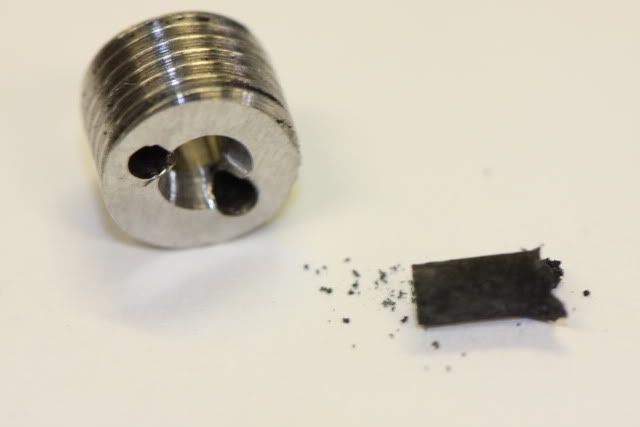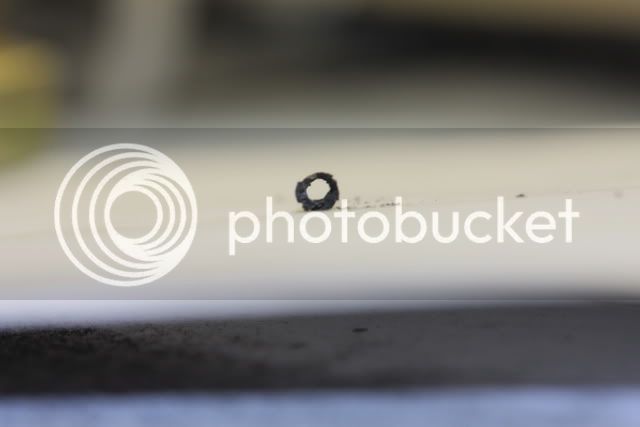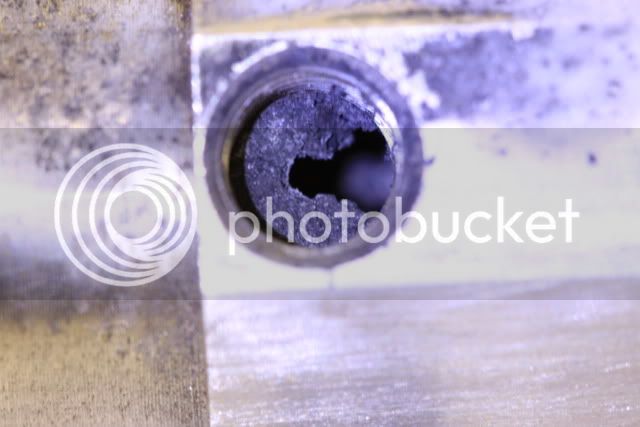Something I noticed yesterday with my .54 Lyman Trade Rifle. When I got some tips from a guy that knows a lot about flinters said that when he loads his gun he likes to see a tiny bit of powder come out of the barrel and into the pan. It never did this and I was shooting with 3f. It would only do it when I took my nipple pick and poked it around in there A LOT!!! Then I would get a couple specks of powder come into the pan. Is it become my factory liner is too small? Or do I need to invest in a pick and brush set for my rifle? I noticed that when I borrowed this guy's pick and brush set for a couple of minutes that day I noticed his vent pick was bigger than a nipple pick but all I have is a nipple pick.
You are using an out of date browser. It may not display this or other websites correctly.
You should upgrade or use an alternative browser.
You should upgrade or use an alternative browser.
Small Touch Hole Liner?
- Thread starter luieb45
- Start date

Help Support Muzzleloading Forum:
This site may earn a commission from merchant affiliate
links, including eBay, Amazon, and others.
- Joined
- Apr 3, 2004
- Messages
- 15,602
- Reaction score
- 22
Well you really shouldn't be poking around in there A LOT!
Is your gun going right off? Are you getting a lot of "Flash in the pan's?" Because if your gun is functioning as it should I wouldn't worry about who's vent is larger, yours or the other guys. Now if you are having ignition problems then yes you may want to look into openning up the vent hole. You can measure it now by getting a numbered drill set and find the one that closly matches your hole and let us know here what it is.
Is your gun going right off? Are you getting a lot of "Flash in the pan's?" Because if your gun is functioning as it should I wouldn't worry about who's vent is larger, yours or the other guys. Now if you are having ignition problems then yes you may want to look into openning up the vent hole. You can measure it now by getting a numbered drill set and find the one that closly matches your hole and let us know here what it is.
- Joined
- Apr 3, 2004
- Messages
- 15,602
- Reaction score
- 22
3f dribbles out of all my vents into the pan, no big deal.
hanshi
Cannon
I don't worry about powder making it through the vent and into the pan. You might try turning the rifle lock side down and smacking the side plate. This often causes a few granules to fall through on the times I've done it. I drill out my touch holes to 1/16" and get reliable ignition. Some go a little larger up to 5/64". The key is whatever gives you reliable ignition is what's right for your rifle.
There are lots of myths and misinformation that gets perpetrated, even here.
Beside the fact that there is rigid testing that shows it is just that, misinformation.
I drill all my touchholes with a #50 drill (.070). If yours is working the way you are satisfied with leave it alone. But personally I don’t believe you need to dribble a few grains of powder out of your touchhole into the pan. I have two Lyman flintlocks and neither was totally reliable from the box. They are now! And no dribbling either!
Beside the fact that there is rigid testing that shows it is just that, misinformation.
I drill all my touchholes with a #50 drill (.070). If yours is working the way you are satisfied with leave it alone. But personally I don’t believe you need to dribble a few grains of powder out of your touchhole into the pan. I have two Lyman flintlocks and neither was totally reliable from the box. They are now! And no dribbling either!
With my squirrel LR that has a SS hex set screw for a liner and a .067 TH dia., I sometimes see powder in the pan from loading but don't really pay that much attention to it. Have never used a TH pick of any kind....the reliabilty and ignition speed of this flintlock are excellent and just can't understand what all the fuss is about asre other flintlocks......Fred
Larry Pletcher
50 Cal.
- Joined
- Jul 27, 2006
- Messages
- 1,313
- Reaction score
- 67
During testing I had a chance to photograph the fouling that shows up in vents that are not managed well. A large vent can turn into a small vent quickly. Here are a few pics of a vent that we experimented with:
#1 I'm using a vent sized drill bit to push out a perfect "pipe" of fouling.
 [/img]
[/img]
#2 Another view of the fouling

#3 Looking through the "pipe"

We saw the same thing with a WL liner. Here is a view looking at the fouling after the liner was carefully removed.

(Since you asked - the WL liner was drilled with 2 small holes so a spanner wrench could be used to remove it. We've done this with a number of liners when we needed to remove one to install another.)
Regards,
Pletch
#1 I'm using a vent sized drill bit to push out a perfect "pipe" of fouling.

#2 Another view of the fouling

#3 Looking through the "pipe"

We saw the same thing with a WL liner. Here is a view looking at the fouling after the liner was carefully removed.

(Since you asked - the WL liner was drilled with 2 small holes so a spanner wrench could be used to remove it. We've done this with a number of liners when we needed to remove one to install another.)
Regards,
Pletch
Larry Pletcher
50 Cal.
- Joined
- Jul 27, 2006
- Messages
- 1,313
- Reaction score
- 67
flehto said:With my squirrel LR that has a SS hex set screw for a liner and a .067 TH dia., I sometimes see powder in the pan from loading but don't really pay that much attention to it. Have never used a TH pick of any kind....the reliabilty and ignition speed of this flintlock are excellent and just can't understand what all the fuss is about asre other flintlocks......Fred
Hi Fred,
I saw you post just after I finished mine. I personally like .067" as well. It allows a pipe cleaner. I don't used one all the time, but it would have paid off the experiment pictured above.
Regards,
Pletch
paulvallandigham
Passed On
- Joined
- Jan 9, 2006
- Messages
- 17,537
- Reaction score
- 92
That .067" TH should hold back most 3Fg granules.
For the uninformed, a .067" diameter hole is made used a #51 drill bit.
A 1/16" hole, is by comparison, .0625".
A 5/64" hole is .0781", and is useful when shooting 2Fg or larger granular powders. However, the 5/64" TH will allow 3Fg powder to spill out of the barrel, giving you minor variations in your main powder charge.
For the uninformed, a .067" diameter hole is made used a #51 drill bit.
A 1/16" hole, is by comparison, .0625".
A 5/64" hole is .0781", and is useful when shooting 2Fg or larger granular powders. However, the 5/64" TH will allow 3Fg powder to spill out of the barrel, giving you minor variations in your main powder charge.
You are the man!
I have been using a #50 drill (.070) but I may try the #51 (.067). I think the 5/64th is getting on the too big side. I have ruined a lot of liners trying to figger this stuff out!
I am not a vent picker either but there just may be so validity in doing so on occasion.
This year, here in Kansas, has been one for the record books with humidity levels and I see a lot of stuff left behind in the pan. Our temps have been way lower than normal so you take what you get and make it work.
I have been using a #50 drill (.070) but I may try the #51 (.067). I think the 5/64th is getting on the too big side. I have ruined a lot of liners trying to figger this stuff out!
I am not a vent picker either but there just may be so validity in doing so on occasion.
This year, here in Kansas, has been one for the record books with humidity levels and I see a lot of stuff left behind in the pan. Our temps have been way lower than normal so you take what you get and make it work.
I have a couple liners I drilled with a 5/64th drill and they worked fine. So I backed off to the #50 (.070) because I thought it may be better being as small as was reliable. I want to try your suggestion of the #51 drill.
The two Lyman rifles I have had a very small holes, less than .0625. They did not shoot well at all. They both have a .070 liner and work, as they should. (One, amongst other little tweaks)
The two Lyman rifles I have had a very small holes, less than .0625. They did not shoot well at all. They both have a .070 liner and work, as they should. (One, amongst other little tweaks)
The only time I pick "in there" is when I am cleaning the gun at the end of the day OR if I have a flash in the pan and no boom problem (which is very rare). Otherwise, I leave my pick out of there.
Luie--if you are getting good ignition there is just no need to fiddle with picking in the vent hole, in my humble opinion.
Luie--if you are getting good ignition there is just no need to fiddle with picking in the vent hole, in my humble opinion.
- Joined
- Apr 3, 2004
- Messages
- 15,602
- Reaction score
- 22
The most important thing is, whether you pick or don't pick, you make sure you do the exact same thing every time, be consistant in your loading technique and you and your gun will be happy. :thumbsup:
Pletch
Was the vent liner you showed in the photos fouled by firing the barrel without a projectile in it?
I have never seen one so plugged up if there was a patched ball or a bullet over the powder !
From what I've seen, with a normal powder load under a roundball the high pressures created in the breech tend to blow out all but a tiny amount of fouling that sticks to the wall in the vent.
IMO, firing a load of powder with nothing, or with something very light like a wad of paper or cotton doesn't create enough pressure to cause black powder to burn cleanly (if that term can be used with black powder) and the low pressures will not clear the vent.
Was the vent liner you showed in the photos fouled by firing the barrel without a projectile in it?
I have never seen one so plugged up if there was a patched ball or a bullet over the powder !
From what I've seen, with a normal powder load under a roundball the high pressures created in the breech tend to blow out all but a tiny amount of fouling that sticks to the wall in the vent.
IMO, firing a load of powder with nothing, or with something very light like a wad of paper or cotton doesn't create enough pressure to cause black powder to burn cleanly (if that term can be used with black powder) and the low pressures will not clear the vent.
Larry Pletcher
50 Cal.
- Joined
- Jul 27, 2006
- Messages
- 1,313
- Reaction score
- 67
Zonie,
We were using a short barrel stub with a light load and used a sabot over the powder. The load was light but snapped the sabot out well. We did not build high pressure as you suspect. Our purpose was to measure ignition time and not to examine fouling. The were a curious sidebar.
Regards,
Pletch
We were using a short barrel stub with a light load and used a sabot over the powder. The load was light but snapped the sabot out well. We did not build high pressure as you suspect. Our purpose was to measure ignition time and not to examine fouling. The were a curious sidebar.
Regards,
Pletch
- Joined
- Sep 24, 2008
- Messages
- 610
- Reaction score
- 855
I'll chime in just for the heck of it. I use ffg in my .62 and my vent is 5/64ths. As part of my loading routine I always pour my charge down the barrel and then give the lock area a slap or two. I then look at the vent to make sure I see the powder kernals inside. Like others have said, I don't get any main charge out into the pan. Seeing those fat kernals of powder crowded up against the inside of the touch hole liner lets me know I'm about to make some noise. A Tom Fuller flint and one push of my priming horn plunger and it's off like a scalded dog every time.
Similar threads
- Replies
- 22
- Views
- 2K



